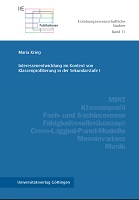Interessenentwicklung im Kontext von Klassenprofilierung in der Sekundarstufe I
Author(s)
Krieg, Maria
Collection
AG UniversitätsverlageLanguage
GermanAbstract
Classes with a special emphasis (so-called profile classes) represent a central element of current school development processes and are considered as one of the most prominent ways of practical implementation of school autonomy. At the secondary level, profile classes in music and science (music and STEM classes)
are becoming increasingly popular. Specific features of profile classes (including additional lessons, innovative and practice-based teaching and learning formats, and the involvement of student labs) are associated with various pedagogical potentials – especially in terms of fostering students’ interest and their
self-concept. However, there is a research gap regarding the development of students’ subject-related interests and their self-concept in profile classes at the secondary level. The findings of the present study indicate differences in the development of the interests in music and
science as well as the domain-specific self-concept between music classes, STEM classes and classes without a specific profile. Using cross-lagged-panel-models, the longitudinal relations among interest and self-concept are estimated in addition to the correlations of the constructs within each wave and the
autoregressive effects within each construct over time. In this regard, differences in the cross-lagged panel models between profile classes and classes without a specific profile are examined. The results allow an evaluation of the potential of profile classes in order to promote students’ interest and self-concept and
offer a variety of implications for pedagogical practice.
Keywords
educational science; profile classes; new learningDOI
10.17875/gup2022-1950ISBN
9783863955441Publisher
Universitätsverlag GöttingenPublication date and place
2022Classification
Education


 Download
Download